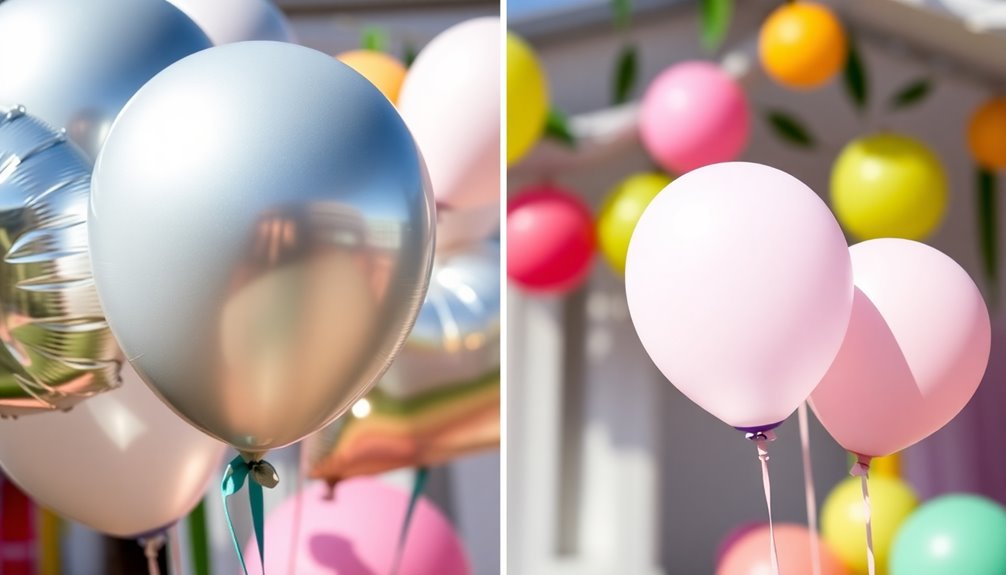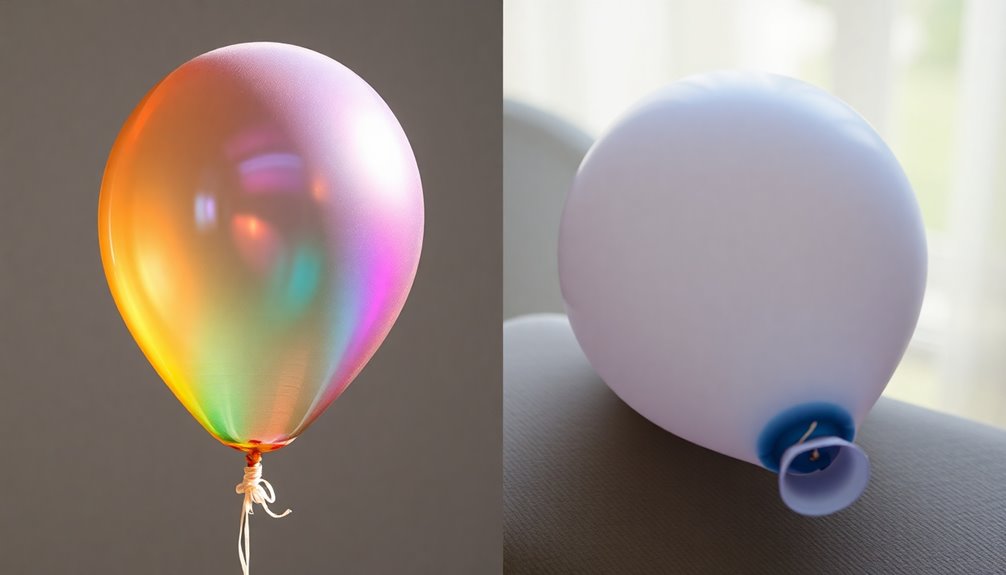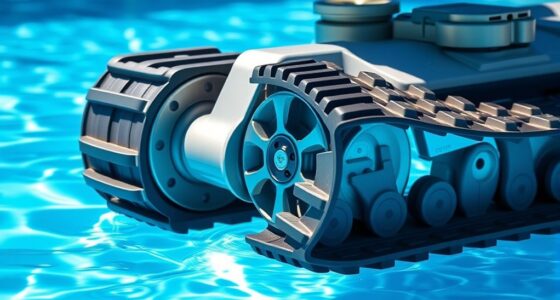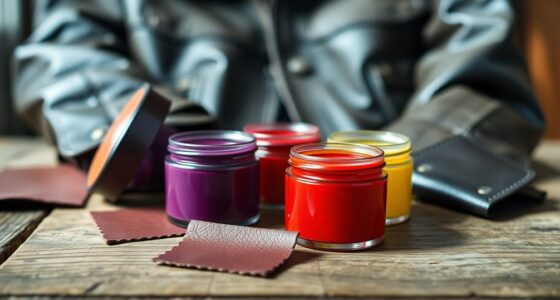When deciding between Mylar and latex balloons, it really depends on your needs. Mylar balloons glide through the air for 1-2 weeks and have a shiny finish, perfect for formal events. However, they're not biodegradable, so they linger in landfills for years. On the other hand, latex balloons are cheaper and eco-friendly, breaking down in about six months. They're great for casual parties thanks to their wide array of colors. Consider what matters most to you—durability or environmental impact—and you'll find the best choice. There's more to help you in making your decision, so keep exploring!
Key Takeaways
- Mylar balloons last longer, floating for 1-2 weeks, while latex balloons typically float for only 8-24 hours.
- Latex balloons are biodegradable and eco-friendly, decomposing within six months, whereas Mylar balloons contribute to long-term plastic pollution.
- Mylar balloons are more expensive, costing 2-5 times more than latex, but can be reused multiple times, offsetting initial costs.
- Aesthetic options vary; Mylar offers glossy finishes and unique shapes, while latex provides a wide color variety for creative designs.
- Mylar balloons are more durable and resistant to temperature changes, making them suitable for outdoor events compared to latex balloons.
Balloon Material Comparison

When you're choosing between Mylar and latex balloons, it's essential to understand their differences in material and performance.
Mylar balloons, made from polyester film, offer a shiny, metallic finish and boast an impressive float time of several days to weeks. In contrast, latex balloons, crafted from natural rubber latex, provide a soft texture but typically float for only 8-24 hours.
If you're concerned about the environment, latex balloons are biodegradable and break down within six months, while Mylar balloons can take decades to decompose.
Additionally, Mylar balloons are more resilient to varying weather conditions, making them ideal for outdoor events. However, if budget matters, latex balloons are generally the more cost-effective option for large gatherings.
Lifespan and Durability

Understanding the lifespan and durability of Mylar versus latex balloons can help you make an informed choice for your event.
Mylar balloons can float for 1-2 weeks when filled with helium, while latex balloons typically last only 8-24 hours. This difference stems from the non-porous nature of Mylar, which prevents helium from escaping, whereas latex balloons have tiny holes that allow gas seepage.
Mylar balloons are also resistant to temperature changes and moisture, making them durable for both indoor and outdoor settings.
Although latex balloons are biodegradable and considered more eco-friendly, they simply don't match the longevity of Mylar balloons.
Plus, Mylar can be reused multiple times, enhancing its overall durability despite being non-biodegradable.
Cost Analysis

Cost plays a significant role in your decision between Mylar and latex balloons. If you're working with a tight budget, latex balloons are a budget-friendly option, often costing around 50% less per unit than Mylar balloons.
Bulk purchasing can further cut costs, making them economical for large events. Conversely, Mylar balloons range from two to five times the price of latex, particularly for custom designs.
Although they've a higher upfront cost, their long-term reuse potential may justify the investment for events that need lasting decorations. If sustainability is a priority for you, consider how the longevity of Mylar balloons may align with your values, balancing initial costs with potential long-term benefits.
Environmental Considerations

When you choose between Mylar and latex balloons, it's important to take into account their environmental impact.
Latex balloons are biodegradable, breaking down in about six months, while Mylar balloons can linger in landfills for decades, creating plastic pollution.
Additionally, environmental regulations in some areas aim to curb balloon releases due to their potential harm to wildlife, making your choice even more significant.
Biodegradability Differences
While many people enjoy balloons for celebrations, the environmental impact of their materials can't be overlooked.
Latex balloons are made from natural rubber, making them biodegradable and able to decompose in about six months. This makes them a more eco-friendly option compared to Mylar balloons.
Mylar balloons, on the other hand, are composed of synthetic polyester film and are non-biodegradable, taking decades to break down. They contribute greatly to plastic pollution.
While some latex balloons can be composted, Mylar balloons lack recycling options, increasing environmental waste.
Choosing biodegradable latex balloons over Mylar can greatly reduce waste and support more sustainable practices in event planning.
Ultimately, being mindful of your balloon choices helps mitigate negative environmental impacts.
Recycling Challenges
Although you might love using balloons for celebrations, the recycling challenges they pose, particularly with Mylar balloons, can't be ignored.
Here are three key issues:
- Non-Biodegradable: Mylar balloons take decades to break down, while latex balloons decompose within six months, presenting significant recycling challenges.
- Complex Materials: The combination of polyester film and aluminum in Mylar balloons complicates recycling processes, as many facilities can't handle them effectively.
- Landfill Impact: Unlike latex balloons, which can sometimes be composted, Mylar balloons usually end up in landfills, contributing to long-term environmental impact.
As awareness grows, it's essential to adopt proper disposal methods and consider more environmentally friendly alternatives for your celebrations.
Environmental Regulations
As concerns over plastic pollution rise, environmental regulations surrounding balloon use are becoming stricter. Mylar balloons, made from non-biodegradable materials, are facing increased scrutiny in various regions. Many states and municipalities now prohibit or regulate balloon releases to protect wildlife from the dangers of balloon debris.
In contrast, latex balloons are considered more environmentally friendly because they decompose within about six months, but proper disposal practices are still essential to mitigate any negative ecological impacts. Awareness campaigns are encouraging the public to choose biodegradable latex options over Mylar alternatives, emphasizing the importance of responsible balloon use.
Aesthetic and Design Options

When planning an event, the aesthetic and design options of balloons can greatly impact the overall vibe. Here's what to contemplate:
- Shapes and Styles: Mylar balloons shine with glossy finishes and come in fun shapes like characters and letters, perfect for themed events.
- Color Variety: Latex balloons offer an extensive range of colors, allowing for creative designs like arches or columns that can elevate casual gatherings.
- Texture Appeal: The contrast between Mylar's smooth, shiny texture and latex's soft, flexible feel adds visual interest to your decor.
Both types can be customized with prints or messages, but Mylar's sophisticated look makes it ideal for formal events, while latex suits more relaxed occasions.
Choose wisely for your event's unique aesthetic!
Choosing the Right Balloon

Selecting the right balloon for your event can make a significant difference in the overall atmosphere.
If you're hosting a formal occasion, Mylar balloons might be your best bet with their shiny, sophisticated look. For casual gatherings, vibrant latex balloons offer versatility and a festive touch.
Consider longevity, too; Mylar balloons can float for 1-2 weeks, while latex balloons typically last only 8-24 hours.
Cost considerations matter, as latex balloons are generally more budget-friendly.
Don't forget about health and environmental factors—Mylar balloons are hypoallergenic for those with latex allergies, but latex balloons are biodegradable, decomposing in about six months.
Weigh these factors carefully to choose the perfect balloons for your event!
Frequently Asked Questions
Are Mylar Balloons Better Than Latex Balloons?
When you consider whether Mylar balloons are better than latex balloons, it really depends on your needs.
Mylar balloons last longer and often look more visually appealing, making them great for special occasions.
However, if you're looking for something eco-friendly, latex balloons decompose faster.
Keep in mind that Mylar balloons can be reused, while latex ones are typically single-use.
Do Mylar Balloons Last Longer Than Latex?
Yes, Mylar balloons last considerably longer than latex ones.
When filled with helium, Mylar balloons can float for 1-2 weeks, while latex balloons typically last just 8-24 hours. This is due to Mylar's non-porous nature, which prevents gas escape.
Additionally, Mylar balloons can handle environmental factors better, allowing them to maintain their float for an extended period.
What Type of Balloon Stays Inflated the Longest?
When you're planning a party, you want balloons that last, right?
Well, Mylar balloons stay inflated the longest. Their non-porous material keeps helium from escaping, so you can enjoy them for 1-2 weeks.
In contrast, latex balloons float only for about 8-24 hours due to their porous nature.
If you're looking for decorations that endure, you'll definitely want to reach for Mylar balloons for your special occasion!
What Is the Best Material for Balloons?
When you're looking for the best material for balloons, consider your needs.
Latex balloons are eco-friendly and biodegradable, making them a great choice if you're concerned about the environment. They're also more affordable.
On the other hand, if you want something that floats longer and offers a shiny finish, Mylar balloons might be your go-to.
Think about the event's theme, budget, and how long you want the balloons to last!
Conclusion
When it comes to choosing between Mylar and latex balloons, it really boils down to your specific needs. If you're after longevity and vibrant designs, Mylar's your best bet. However, if you're looking for eco-friendliness and cost-effectiveness, latex balloons might be the way to go. Ultimately, it's about picking the right tool for the job. Remember, you can't put all your eggs in one basket—consider what matters most to you before making your choice!









